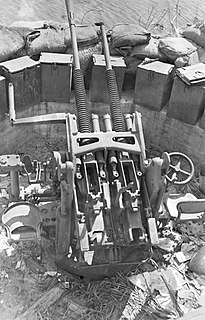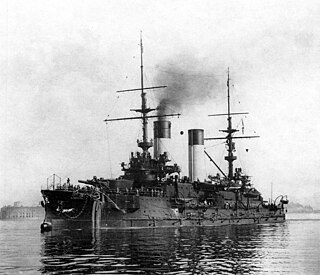
Fusō was the lead ship of the two Fusō-class dreadnought battleships built for the Imperial Japanese Navy. Launched in 1914 and commissioned in 1915, she initially patrolled off the coast of China, playing no part in World War I. In 1923, she assisted survivors of the Great Kantō earthquake.
The MG 15 was a German 7.92 mm machine gun designed specifically as a hand manipulated defensive gun for combat aircraft during the early 1930s. By 1941 it was replaced by other types and found new uses with ground troops.
Rate of fire is the frequency at which a specific weapon can fire or launch its projectiles. It is usually measured in rounds per minute, or rounds per second.
The China Expeditionary Army was an army group of the Imperial Japanese Army during the Second Sino-Japanese War and World War II. It was responsible for all military operations in China, and at its peak had over 1 million soldiers under its command. In military literature, it is often referred to by the initials CEA.

The Type 96 25mm Gun was an automatic cannon used by the Imperial Japanese Navy during World War II. A locally-built variant of the French Hotchkiss 25mm anti-aircraft gun, it was designed as a dual-purpose weapon for use against armored vehicles and aircraft, but was primarily used as an anti-aircraft gun in fixed mounts with between one and three guns.

Matsushima (松島) was a Matsushima-class protected cruiser of the Imperial Japanese Navy. Like her sister ships, her name comes from one of the traditional Three Views of Japan, in this case, the Matsushima archipelago near Sendai in Miyagi prefecture.

The Danton-class battleship was a class of six pre-dreadnought battleships built for the French Navy before World War I. The ships were assigned to the Mediterranean Fleet after commissioning in 1911. After the beginning of World War I in early August 1914, five of the sister ships participated in the Battle of Antivari. They spent most of the rest of the war blockading the Straits of Otranto and the Dardanelles to prevent warships of the Central Powers from breaking out into the Mediterranean. One ship was sunk by a German submarine in 1917.

The Imperatritsa Ekaterina Velikaya was the second ship of the Imperatritsa Mariya-class dreadnoughts of the Imperial Russian Navy. She was begun before World War I, completed in 1915 and saw service with the Black Sea Fleet. She engaged the ex-German battlecruiser Yavuz once, but only inflicted splinter damage while taking no damage herself. She was renamed Svobodnaya Rossiya after the February Revolution, but saw no further combat. She was evacuated from Sevastopol as the Germans approached in May 1918, but was scuttled in Novorossiysk harbor the following month when the Germans demanded that the Soviets hand her over according to the terms of the Treaty of Brest-Litovsk.

Azuma (吾妻) was an armored cruiser built for the Imperial Japanese Navy (IJN) in the late 1890s. As Japan lacked the industrial capacity to build such warships herself, the ship was built in France. She participated in most of the naval battles of the Russo-Japanese War of 1904–05 and was lightly damaged during the Battle off Ulsan and the Battle of Tsushima. Azuma began the first of five training cruises in 1912 and saw no combat during World War I. She was never formally reclassified as a training ship although she exclusively served in that role from 1921 until she was disarmed and hulked in 1941. Azuma was badly damaged in an American carrier raid in 1945, and subsequently scrapped in 1946.

Yakumo was an armored cruiser built for the Imperial Japanese Navy (IJN) in the late 1890s. As Japan lacked the industrial capacity to build such warships herself, the ship was built in Germany. She participated in most of the naval battles of the Russo-Japanese War of 1904–05, and was lightly damaged during the Battle of the Yellow Sea and the Battle of Tsushima. Yakumo saw no combat during World War I and began the first of many training cruises in 1917, although she was not officially reclassified as a training ship until 1931. Her last training cruise was in 1939, but the ship continued to conduct training in home waters throughout the Pacific War. Yakumo became a repatriation transport after the war and was broken up in 1946–47.

Oryol was a Borodino-class battleship built for the Russian Imperial Navy in the first decade of the 20th century. The ship was completed a few months before the start of the Russo-Japanese War in February 1904 and was assigned to the Second Pacific Squadron sent to the Far East six months later to break the Japanese blockade of Port Arthur. The Japanese captured the port while the squadron was in transit and their destination was changed to Vladivostok. Oryol was badly damaged during the Battle of Tsushima in May 1905 and surrendered to the Japanese who put her into service under the name of Iwami.

The 76.2 mm divisional gun model 1902 was a Russian light field gun used in the Russo-Japanese War, World War I, Russian Civil War and a number of interwar armed conflicts with participants from the former Russian Empire. Modernized versions of this gun were employed at the early stage of World War II.

The 6.5×50 Japanese Arisaka, 6.5mm Japanese Arisaka, 6.5 Jap, or 6.5x50mmSR Arisaka is a semi-rimmed cartridge, with a 6.5 mm (.264) diameter bullet. Historically it has been referred to as the "6.5 Jap". The 6.5x50 Japanese Arisaka naming convention follows common European naming conventions. The first part of the cartridge's name refers to the diameter of the bullet followed by the case length in millimeters. It was adopted by the Imperial Japanese Army in 1897, along with the Type 30 Arisaka infantry rifle and carbine. The new rifle and cartridge replaced the 8×52mm Murata round used in the Type 22 Murata rifle. In 1902, the Imperial Japanese Navy chambered its Type 35 rifle for the cartridge as well. In 1905, the round also came to be offered in the Type 38 Arisaka infantry rifle and carbine, both of which rendered the Type 30 obsolete in imperial army service. Type 44 cavalry carbines, first adopted in 1911, were also chambered in 6.5×50mm.

The Blockade of Wonsan, or the Siege of Wonsan, from February 16, 1951 to July 27, 1953, during the Korean War, was the longest naval blockade in modern history, lasting 861 days. UN naval forces, primarily from the United States, successfully kept the strategically important city of Wonsan from being used by the North Korean Navy.

The Battle for Henderson Field, also known as the Battle of Guadalcanal or Battle of Lunga Point by the Japanese, took place from 23 to 26 October 1942 on and around Guadalcanal in the Solomon Islands. The battle was a land, sea, and air battle of the Pacific campaign of World War II and was fought between the Imperial Japanese Army and Navy and Allied forces. The battle was the third of the three major land offensives conducted by the Japanese during the Guadalcanal campaign.
The Kii-class battleship was a planned class of four fast battleships to be built for the Imperial Japanese Navy (IJN) during the 1920s. Only two of the ships received names. They were intended to reinforce Japan's "eight-eight fleet" of eight battleships and eight battlecruisers after the United States announced a major naval construction program in 1919. However, after the signing of the Washington Naval Treaty in 1922, work on the ships was suspended; one pair was cancelled in November 1923 and the other in April 1924.

The Nagato-class battleships were a pair of dreadnought battleships built for the Imperial Japanese Navy (IJN) during World War I, although they were not completed until after the end of the war. Nagato, the lead ship of the class, frequently served as a flagship. Both ships carried supplies for the survivors of the Great Kantō earthquake in 1923. They were modernized in 1933–36 with improvements to their armor and machinery and a rebuilt superstructure in the pagoda mast style. Nagato and her sister ship Mutsu briefly participated in the Second Sino-Japanese War in 1937 and Nagato was the flagship of Admiral Isoroku Yamamoto during the attack on Pearl Harbor on 7 December 1941 that began the Pacific War.

The Type 1 Gun tank Ho-Ni I was a tank destroyer and self-propelled artillery developed by the Imperial Japanese Army for use during World War II in the Pacific theater.
The Battle of Hengyang was the longest defense of a single city of the entire Second Sino-Japanese War. When Changsha fell to the Imperial Japanese Army on June 19, 1944, Hengyang became their next target. The reorganized 11th Army, consisting of 10 divisions, 4 brigades, and over 110,000 men, assumed the task of attacking Hengyang.

The Ibuki-class cruisers were the last class of heavy cruisers built for the Imperial Japanese Navy (IJN). In order to save design time, the ships were essentially repeats of the earlier Mogami class. Begun during World War II, only the lead ship, Ibuki, was launched, but she was in the process of being converted into a light aircraft carrier when construction was suspended in 1945. She was scrapped the following year. The unnamed second ship was scrapped less than a month after being laid down in order to clear her slipway for an aircraft carrier.



















